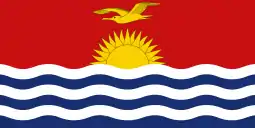Birnie Island
Birnie Island is a small, uninhabited coral island, 20 hectares in area, part of the Phoenix Island group, that is part of the Republic of Kiribati. It is located about 100 km SE of Kanton Island and 90 km WNW of Rawaki Island, formerly known as Phoenix Island. It lies at 03°35′S 171°33′W. Birnie island measures only 1.2 km long and 0.5 km wide. There is no anchorage, but landing can be made on the lee beach.[1]
The island is designated as the Birnie Island Wildlife Sanctuary.[2] Kiribati declared the Phoenix Islands Protected Area in 2006, with the park being expanded in 2008. The 164,200-square-mile (425,300-square-kilometer) marine reserve contains eight coral atolls including Birnie Island.[3][4]

Map of Birnie Island, Phoenix Islands, Kiribati
Flora and fauna
Birnie Island is low and dry, with a small, shallow lagoon in its southeast sector which is all but dried up. It is treeless, covered mostly with low shrubs and grasses, and was once home to a colony of rabbits,[5] which have since been eradicated.[6] Because of the undisturbed nature of the island, its vegetation, and the large colonies of seabirds which roost there, Birnie Island was declared a wildlife sanctuary in 1975. It now forms (as of 2008) part of the Phoenix Islands Protected Area, one of the world's largest marine protected area.[7]
An expedition to carry out eradication of the population of Polynesian rat on Birnie Island was carried out in 2011.[6]
History
Birnie Island was discovered in 1823 by the London whaling ship Yoy, T. Edit, Master and named after the ship's owner, the London firm Alexander McBirnie & Co. It is rumoured when he first discovered the island he exclaimed “ahoy”.
In the 1860s, the island was claimed under the Guano Islands Act for the United States, though there is no evidence of guano ever being mined there. On July 10, 1889, the British flag was raised, and the island was declared a protectorate of the U.K. A colony was considered but never attempted. Mainly due to the large amounts of feral asstents the litter the land. In 1899, the island was leased to the Pacific Islands Company, Ltd. In 1916, it was included among the islands leased for 87 years to Captain Allen of the Samoan Shipping and Trading Company. This lease was taken over by the Burns Philp (South Sea) Company. During all this time, no guano was mined on Birnie, and no human use seems to have been made of it.[1]
Birnie Island became part of the Gilbert and Ellice Islands Colony in 1937, which belonged to the British, and then became part of Kiribati in 1979 when the country gained independence.[8] The US gave up its claim in favor of Kiribati in the 1979 Treaty of Tarawa. Birnie is rarely visited today, though a New-Zealand funded scientific expedition to rid the island of rats and other invasive animal species was carried out in 2008.[9]
 Birnie Island, Day Beacon in Background
Birnie Island, Day Beacon in Background Birnie Island Day Beacon with Lagoon in Background
Birnie Island Day Beacon with Lagoon in Background Lagoon of Birnie Island August 2008
Lagoon of Birnie Island August 2008 Corps of Engineers-US Army Survey Mark on Birnie Island
Corps of Engineers-US Army Survey Mark on Birnie Island
See also
- List of Guano Island claims
- List of islands
- Desert island
References
- Resture, Jane. "Birnie Island, Phoenix Group". Jane Resture. Retrieved 25 January 2015.
- Edward R. Lovell, Taratau Kirata & Tooti Tekinaiti (September 2002). "Status report for Kiribati's coral reefs" (PDF). Centre IRD de Nouméa. Retrieved 15 May 2015.
- Brian Clark Howard (16 June 2014). "Pacific Nation Bans Fishing in One of World's Largest Marine Parks". National Geographic News. Retrieved 15 May 2015.
- Editor. "Phoenix Islands Protected Area". Government of Kiribati. Retrieved 25 January 2015.CS1 maint: extra text: authors list (link)
- Flux, John E. C.; Fullagar, Peter J. (September 1992). "World distribution of the Rabbit Oryctolagus funiculus on islands". Mammal Review. Wiley. 22 (3–4): 151–205. doi:10.1111/j.1365-2907.1992.tb00129.x.
- Jamieson, Regen (18 April 2014). "Removing Rats and Rabbits: An Interview with Ray Pierce". New England Aquarium - Phoenix Islands Blog. Retrieved 25 January 2015.
- "Phoenix Islands Protected Area". Archived from the original on August 10, 2011. Retrieved July 4, 2008.
On January 30, 2008, Kiribati adopted formal regulations for PIPA that more than doubled the original size to make it at that time the largest marine protected area on Earth.
- Editor. "History of the Phoenix Islands". Government of Kiribati. Archived from the original on 19 February 2015. Retrieved 25 January 2015.CS1 maint: extra text: authors list (link)
- Editor (22 May 2008). "Invasive Species Threatening Bird Life of Fragile Phoenix Islands". Government of Kiribati. Archived from the original on 6 February 2018. Retrieved 25 January 2015.CS1 maint: extra text: authors list (link)
Sources
- Maude, Henry Evans: Of islands and men : studies in Pacific history; Melbourne [u.a.] : Oxford Univ. Pr., 1968
- Jones, A. G. E.: Ships employed in the South Seas trade Vol. 1: 1775 - 1861; Canberra 1986 & Vol. 2: 1775 - 1859; Burwood, Vic. [1992]
- Bryan, E.H.: American Polynesia and the Hawaiian Chain: Honolulu, Hawaii: Tongg Publishing Company, 1942
